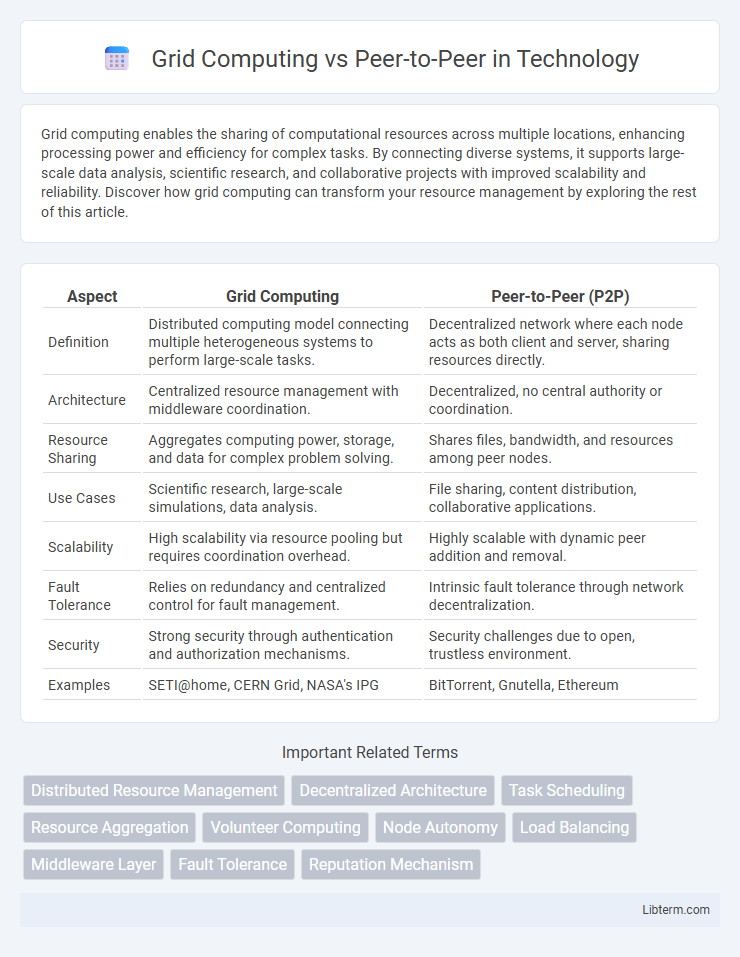Grid computing enables the sharing of computational resources across multiple locations, enhancing processing power and efficiency for complex tasks. By connecting diverse systems, it supports large-scale data analysis, scientific research, and collaborative projects with improved scalability and reliability. Discover how grid computing can transform your resource management by exploring the rest of this article.
Table of Comparison
| Aspect | Grid Computing | Peer-to-Peer (P2P) |
|---|---|---|
| Definition | Distributed computing model connecting multiple heterogeneous systems to perform large-scale tasks. | Decentralized network where each node acts as both client and server, sharing resources directly. |
| Architecture | Centralized resource management with middleware coordination. | Decentralized, no central authority or coordination. |
| Resource Sharing | Aggregates computing power, storage, and data for complex problem solving. | Shares files, bandwidth, and resources among peer nodes. |
| Use Cases | Scientific research, large-scale simulations, data analysis. | File sharing, content distribution, collaborative applications. |
| Scalability | High scalability via resource pooling but requires coordination overhead. | Highly scalable with dynamic peer addition and removal. |
| Fault Tolerance | Relies on redundancy and centralized control for fault management. | Intrinsic fault tolerance through network decentralization. |
| Security | Strong security through authentication and authorization mechanisms. | Security challenges due to open, trustless environment. |
| Examples | SETI@home, CERN Grid, NASA's IPG | BitTorrent, Gnutella, Ethereum |
Introduction to Grid Computing and Peer-to-Peer
Grid computing harnesses distributed computing resources across multiple locations to solve complex problems by sharing processing power, storage, and data in a coordinated manner. Peer-to-Peer (P2P) networks enable decentralized communication and resource sharing among interconnected devices without relying on a central server, promoting scalability and fault tolerance. Both models emphasize resource optimization but differ in architecture: grid computing uses structured, managed resource allocation, while P2P relies on autonomous, equal nodes.
Core Architecture Comparison
Grid computing architecture relies on a centralized resource management system that coordinates multiple distributed computing resources to achieve high-performance tasks through workload distribution and resource sharing. Peer-to-peer (P2P) architecture operates on a decentralized model where each node functions as both client and server, enabling direct communication and resource exchange without a central authority. While grid computing emphasizes controlled resource allocation and task scheduling, P2P networks leverage dynamic, ad-hoc connectivity for scalability and fault tolerance in distributed environments.
Resource Management in Grid vs Peer-to-Peer
Grid computing employs centralized resource management systems that coordinate distributed resources to optimize performance and ensure efficient job scheduling. Peer-to-peer networks rely on decentralized resource management, where each node autonomously contributes and consumes resources, leading to dynamic and scalable resource sharing. The grid's hierarchical control improves resource allocation predictability, whereas peer-to-peer's decentralized approach enhances fault tolerance and adaptability in heterogeneous environments.
Scalability and Flexibility
Grid computing offers high scalability by aggregating resources across multiple administrative domains, enabling efficient processing of large-scale computational tasks. Peer-to-peer (P2P) networks provide exceptional flexibility with decentralized resource sharing, allowing dynamic addition and removal of nodes without significant performance degradation. While grid computing excels in structured environments with predictable workloads, P2P systems adapt better to heterogeneous and volatile network conditions, enhancing overall resource availability and fault tolerance.
Security Challenges and Solutions
Grid computing faces security challenges such as authentication across heterogeneous domains, secure resource sharing, and data integrity enforcement, requiring robust identity management systems and encryption protocols. Peer-to-peer networks encounter issues like node trustworthiness, data privacy, and resistance to malicious attacks, relying on decentralized trust models and encryption methods for protection. Both paradigms benefit from techniques like public key infrastructure (PKI), intrusion detection systems, and reputation-based mechanisms to enhance overall security resilience.
Fault Tolerance and Reliability
Grid Computing enhances fault tolerance by distributing tasks across multiple dedicated resources with centralized monitoring, enabling robust error detection and recovery mechanisms. Peer-to-Peer networks rely on decentralized nodes that dynamically share workload, offering resilience through redundancy but facing challenges in maintaining consistent reliability due to node volatility. Both architectures improve fault tolerance, yet Grid Computing typically provides higher reliability via controlled resource management and systematic fault handling protocols.
Use Cases and Applications
Grid computing excels in large-scale scientific research, such as climate modeling and genome sequencing, where pooling distributed resources enables complex data processing tasks. Peer-to-peer networks are optimal for decentralized applications like file sharing, blockchain technologies, and collaborative platforms that require resilience and direct node interaction. Both models support distributed computing but differ in architecture and ideal application scenarios based on resource management and network control.
Performance Metrics and Analysis
Grid computing delivers high-performance by harnessing geographically dispersed resources, optimizing workload distribution, and enabling parallel processing for large-scale tasks. Peer-to-peer networks excel in scalability and fault tolerance, providing dynamic resource sharing with minimal centralized control and lower latency for decentralized applications. Performance metrics such as throughput, latency, fault resilience, and resource utilization are critical in analyzing Grid computing's efficiency in batch processing compared to Peer-to-Peer's responsiveness and adaptability in real-time data exchange.
Cost Efficiency and Resource Utilization
Grid computing optimizes cost efficiency by aggregating distributed resources to handle large-scale tasks, reducing the need for expensive centralized infrastructure. Peer-to-peer networks enhance resource utilization through direct sharing among nodes, minimizing overhead and enabling scalable, decentralized processing. Both models improve cost management and resource allocation but differ in control and complexity, with grid computing suited for coordinated, high-performance workloads and peer-to-peer excelling in flexibility and fault tolerance.
Future Trends in Distributed Computing
Emerging trends in distributed computing reveal that grid computing is evolving towards more flexible, resource-sharing architectures with enhanced virtualization and cloud integration, enabling large-scale scientific and enterprise applications to achieve higher efficiency and scalability. Peer-to-peer (P2P) networks, driven by blockchain technology and decentralized applications (dApps), focus on robust data distribution, fault tolerance, and improved security through consensus mechanisms and cryptographic protocols. Future developments emphasize hybrid models combining grid and P2P strengths to support edge computing, real-time analytics, and AI workloads across diverse, heterogeneous environments.
Grid Computing Infographic

 libterm.com
libterm.com